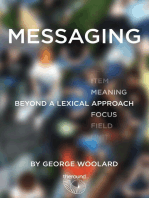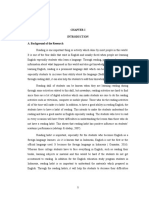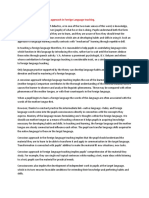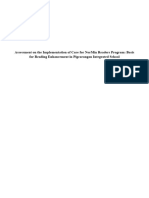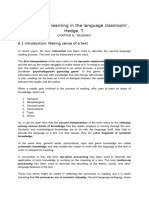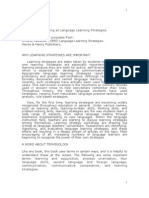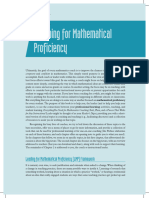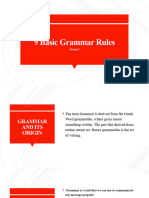Reading
Reading
Uploaded by
ahdahdaghCopyright:
Available Formats
Reading
Reading
Uploaded by
ahdahdaghCopyright
Available Formats
Share this document
Did you find this document useful?
Is this content inappropriate?
Copyright:
Available Formats
Reading
Reading
Uploaded by
ahdahdaghCopyright:
Available Formats
1. Teaching Reading What is reading? Reading is about understanding written texts.
It is a complex activity that involves both perception and thought. Reading consists of two related processes: word recognition and comprehension. Word recognition refers to the process of perceiving how written symbols correspond to ones spoken language. Comprehension is the process of making sense of words, sentences and connected text. Readers typically make use of background knowledge, vocabulary, grammatical knowledge, experience with text and other strategies to help them understand written text. Much of what we know about reading is based on studies conducted in English and other alphabetic languages. The principles we list in this booklet are derived from them, but most also apply to non-alphabetic languages. They will have to be modified to account for the specific language. Learning to read is an important educational goal. For both children and adults, the ability to read opens up new worlds and opportunities. It enables us to gain new knowledge, enjoy literature, and do everyday things that are part and parcel of modern life, such as, reading the newspapers, job listings, instruction manuals, maps and so on. Most people learn to read in their native language without difficulty. Many, but not all, learn to read as children. Some children and adults need additional help. Yet others learn to read a second, third or additional language, with or without having learned to read in their first language. Reading instruction needs to take into account different types of learners and their needs. Research has shown that there is a great deal of transfer from learning to read in one language to learning to read in a second language. The principles outlined below are based on studies of children and adults, native speakers as well as those learning to read in a second or foreign language. They deal with different aspects of reading that are important in the planning and design of instruction and materials. The practical applications are based on general learning principles, as well as on research. Briefly stated, these learning principles start with the learner in mind. The type of learner will affect the type of methods and materials to be used. The context of learning is also important. For instance, children and adults who are learning to read in a language different from their native language will also need to learn about the culture of the second or foreign language. Because texts are written with a specific audience in mind, cultural knowledge is present in texts and it is assumed that the reader is familiar with such knowledge. Both research and classroom practices support the use of a balanced approach in instruction. Because reading depends on efficient word recognition and comprehension, instruction should develop reading skills and strategies, as well as build on learners knowledge through the use of authentic texts.
You might also like
- The Levels of Reading Comprehension of The 21st Century LearnersDocument36 pagesThe Levels of Reading Comprehension of The 21st Century LearnersJanna Dublas50% (8)
- Messaging: beyond a lexical approach in ELTFrom EverandMessaging: beyond a lexical approach in ELTRating: 5 out of 5 stars5/5 (1)
- Authentic Reading ExperienceDocument5 pagesAuthentic Reading ExperienceNoor Suhada Bt MisromNo ratings yet
- Accents Lesson PlanDocument2 pagesAccents Lesson PlanNathanael LePageNo ratings yet
- Learning Reading SkillsDocument12 pagesLearning Reading SkillsJavaria Ali50% (2)
- Teaching Reading at An Advanced LevelDocument16 pagesTeaching Reading at An Advanced LevelWalter Morales NeyreNo ratings yet
- Pham Thu HuongDocument15 pagesPham Thu HuongThảo EmNo ratings yet
- Teach Students To Adapt Their Speech To Situations.Document5 pagesTeach Students To Adapt Their Speech To Situations.ahdahdaghNo ratings yet
- Reading ComprehensionDocument25 pagesReading ComprehensionPeter A Diaz100% (2)
- INTRODUCTIONDocument12 pagesINTRODUCTIONAstenaLargamaNo ratings yet
- ProposalDocument33 pagesProposalHeriani panjangnipahNo ratings yet
- The Impact of Reading Strategy Training On The Reading Comprehension of Iranian EFL LearnersDocument6 pagesThe Impact of Reading Strategy Training On The Reading Comprehension of Iranian EFL LearnersCLE ANN lacsonNo ratings yet
- Teachers' Im'sDocument19 pagesTeachers' Im'sCMarie Cachero PazNo ratings yet
- Comparative StudiesDocument66 pagesComparative StudiesJasmin CaballeroNo ratings yet
- Principle of Conscious Approach in Foreign Language TeachingDocument44 pagesPrinciple of Conscious Approach in Foreign Language TeachingAynura İsgandarovaNo ratings yet
- ReportDocument32 pagesReportDarvius ANtoniNo ratings yet
- Chapter IDocument7 pagesChapter IluryandreandehNo ratings yet
- Final Project Reading: Student's Name: Lizeth Mezquite ReyesDocument30 pagesFinal Project Reading: Student's Name: Lizeth Mezquite ReyesLizeth ReyesNo ratings yet
- ResearchDocument10 pagesResearchYukiko HachiNo ratings yet
- Seminar On ELTDocument13 pagesSeminar On ELTWindi PutriNo ratings yet
- : A COMPARATIVE STUDY OF READING COMPREHENSION OF SELECTED SOPHOMORE STUDENTS IN POLYTECHNIC UNIVERSITY OF THE PHILIPPINES QUEZON CITY CAMPUS BETWEEN A.Y. 2011-2012 AND A.Y. 2012-2013 CORRELATES TO OTHER VARIABLESDocument66 pages: A COMPARATIVE STUDY OF READING COMPREHENSION OF SELECTED SOPHOMORE STUDENTS IN POLYTECHNIC UNIVERSITY OF THE PHILIPPINES QUEZON CITY CAMPUS BETWEEN A.Y. 2011-2012 AND A.Y. 2012-2013 CORRELATES TO OTHER VARIABLESJasmin Caballero98% (42)
- Teaching ReadingDocument14 pagesTeaching Readingangelito pera100% (1)
- Unit 8. Written Foreign Language. Approximation, consolidation and improvement of the reading-writing process. Reading comprehension: global and specific comprehension strategies. The writing process: from the interpretation to the production of textsDocument6 pagesUnit 8. Written Foreign Language. Approximation, consolidation and improvement of the reading-writing process. Reading comprehension: global and specific comprehension strategies. The writing process: from the interpretation to the production of textsPaloma EstebanNo ratings yet
- Research 1Document10 pagesResearch 1dp604794No ratings yet
- Dilafruz Kurs IshiDocument29 pagesDilafruz Kurs IshiDilafruz KuchkarovaNo ratings yet
- Darwin Real ThesisDocument36 pagesDarwin Real ThesisDarwin Dio LimboNo ratings yet
- Goals and Techniques For Teaching ListeningDocument23 pagesGoals and Techniques For Teaching ListeningArmen Neziri100% (1)
- 03aslan Yasin Baku PaperDocument10 pages03aslan Yasin Baku PaperJuli MombaNo ratings yet
- READING SKILL TEMA 8 Del 21 FDocument6 pagesREADING SKILL TEMA 8 Del 21 FsierracuestanegraNo ratings yet
- Lesson1 LiteracyDocument6 pagesLesson1 LiteracyAlyssa EstreraNo ratings yet
- Reading Comprehension in Teaching English As A Foreign LanguageDocument14 pagesReading Comprehension in Teaching English As A Foreign Languageapi-195554424No ratings yet
- Thesis On Language Teaching PDFDocument7 pagesThesis On Language Teaching PDFmaggiecavanaughmadison100% (2)
- What Is Reading ComprehensionDocument12 pagesWhat Is Reading ComprehensionIoana DuminicelNo ratings yet
- Review of Literature and Study On Reading ComprehensionDocument4 pagesReview of Literature and Study On Reading ComprehensionMagelyn NB71% (14)
- 12ght01a Jose FinalDocument86 pages12ght01a Jose FinalGillian AdonaNo ratings yet
- Extensive ReadingDocument8 pagesExtensive ReadingRia WiniamsyahNo ratings yet
- Linguistics in Reading (Final Exam)Document12 pagesLinguistics in Reading (Final Exam)Bonjovi HajanNo ratings yet
- Incorporating Directed Reading Thinking Activity (Drta) Technique Into Extensive Reading ClassDocument19 pagesIncorporating Directed Reading Thinking Activity (Drta) Technique Into Extensive Reading ClassoviNo ratings yet
- English Teaching Forum (2011) - Reading LogsDocument9 pagesEnglish Teaching Forum (2011) - Reading Logsausannette100% (1)
- 5 Ways To Support Students Who Struggle With Reading ComprehensionDocument4 pages5 Ways To Support Students Who Struggle With Reading ComprehensionJherick TacderasNo ratings yet
- Macro Skills and Reading PurposesDocument3 pagesMacro Skills and Reading Purposesgincky azuelaNo ratings yet
- Angcos Activity 2 Irc 2Document10 pagesAngcos Activity 2 Irc 2honey beeNo ratings yet
- Hedge T. Ch. 6 ReadingDocument9 pagesHedge T. Ch. 6 ReadingMili SoléNo ratings yet
- Chapter 2Document12 pagesChapter 2Nella Diane Ismael Biaban50% (2)
- Atria Salsabila Nur 1847041002 Paper EspDocument15 pagesAtria Salsabila Nur 1847041002 Paper EspatriaNo ratings yet
- Principles of Language Acquisition and Learning Lesson 4-Reading ApproachesDocument10 pagesPrinciples of Language Acquisition and Learning Lesson 4-Reading ApproachesJayson De Leon SandovalNo ratings yet
- Teaching Receptive Skills A Paper EnglisDocument13 pagesTeaching Receptive Skills A Paper EnglisNathalia Leonor GOMEZ CAICEDONo ratings yet
- Chapter I1Document25 pagesChapter I1umiNo ratings yet
- Chapter 1Document10 pagesChapter 1aligoanteng41No ratings yet
- The Background of The StudyDocument10 pagesThe Background of The StudyMayank Aryanti Ar WhsNo ratings yet
- Judul Ka DuaDocument3 pagesJudul Ka DuaSetia AsNo ratings yet
- Assignment ON Intensive and Extensive Reading Activities: Submitted By, S.V. Allan Sharmila, REG. NO: 19BDEN04Document7 pagesAssignment ON Intensive and Extensive Reading Activities: Submitted By, S.V. Allan Sharmila, REG. NO: 19BDEN04Anto0% (1)
- Teaching ReadingDocument5 pagesTeaching ReadingRembulan Onaa Unny100% (1)
- Action Research MARICELDocument25 pagesAction Research MARICELGemma SumileNo ratings yet
- Master in Teaching English As A Foreign LanguageDocument20 pagesMaster in Teaching English As A Foreign LanguageViviana LopezNo ratings yet
- Teaching ReadingDocument12 pagesTeaching ReadingDado Dodo100% (1)
- Factors Affecting Reading Comprehension in Cebuano and English Language TextsDocument11 pagesFactors Affecting Reading Comprehension in Cebuano and English Language TextsIJELS Research JournalNo ratings yet
- Looking at Language Learning StrategiesDocument17 pagesLooking at Language Learning Strategiesapi-3716467100% (2)
- Teaching Language in 4 SkillsDocument4 pagesTeaching Language in 4 SkillsThuỷ LươngNo ratings yet
- Suren Official Thesis Chapters 1-5Document66 pagesSuren Official Thesis Chapters 1-5eymi espinosaNo ratings yet
- MULTIPLE ROOTS REVERSE CUTHILL-McKEE MET PDFDocument10 pagesMULTIPLE ROOTS REVERSE CUTHILL-McKEE MET PDFvttrlcNo ratings yet
- Application of C Programming in Research and Development ProjectsDocument3 pagesApplication of C Programming in Research and Development Projectsharemurari822No ratings yet
- Soal Pas GRAMMAR Kelas X FixDocument6 pagesSoal Pas GRAMMAR Kelas X FixMAS AL ROSYIDNo ratings yet
- Data Structures Jan 2024Document1 pageData Structures Jan 2024meghanakontham28No ratings yet
- Question Bank For Grade 9th IslamiatDocument6 pagesQuestion Bank For Grade 9th IslamiatkholaNo ratings yet
- Reported Speech 1Document6 pagesReported Speech 1Neila Bolzan100% (1)
- Graph Theory (Lesson)Document22 pagesGraph Theory (Lesson)Princess GinezNo ratings yet
- Math Proficiency - 15648 ChapterDocument11 pagesMath Proficiency - 15648 ChapterAnkur AggarwalNo ratings yet
- Narrative Text FixDocument8 pagesNarrative Text FixRikka TakanashiNo ratings yet
- Shift and Rotate InstructionsDocument21 pagesShift and Rotate Instructionsali chaudaryNo ratings yet
- Hello Secondary 3 The First PartDocument22 pagesHello Secondary 3 The First PartAhmedNo ratings yet
- Éß Ü N TSS ¡P GHK2 - Tiß NG Anh 6 - Éß Ü SSS Æ 1Document3 pagesÉß Ü N TSS ¡P GHK2 - Tiß NG Anh 6 - Éß Ü SSS Æ 1Quỳnh Nguyễn DiễmNo ratings yet
- Cross (2007) - Music and Cognitive Evolution PDFDocument54 pagesCross (2007) - Music and Cognitive Evolution PDFFederico WimanNo ratings yet
- Focus2 2E Workbook Answers PDFDocument1 pageFocus2 2E Workbook Answers PDFРоксоляна Бубон0% (1)
- The Viking Age A Reader - Angus A. Somerville and R. Andrew McDonaldDocument550 pagesThe Viking Age A Reader - Angus A. Somerville and R. Andrew McDonaldmontecinoscervantesrodrigoomarNo ratings yet
- C++ CSC1181Document3 pagesC++ CSC1181Jessica StewartNo ratings yet
- LKPD Narrative TextDocument9 pagesLKPD Narrative TextNi Luh Manik Santi Devi Sitangsu100% (2)
- Stative Verbs ListDocument3 pagesStative Verbs ListJanet100% (1)
- Let Permit Something To Happen: Causative Verbs in English: Let, Make, Have, Get, HelpDocument7 pagesLet Permit Something To Happen: Causative Verbs in English: Let, Make, Have, Get, HelpDunis SantosNo ratings yet
- Argumentative EssayDocument3 pagesArgumentative EssayotpengNo ratings yet
- OpenText Vendor Invoice Management For SAP Solutions 7.5 SP7 - Configuration Guide English (VIM070500-07-CGD-EN-02)Document922 pagesOpenText Vendor Invoice Management For SAP Solutions 7.5 SP7 - Configuration Guide English (VIM070500-07-CGD-EN-02)Varsha Pawaskar100% (4)
- 5 StackDocument10 pages5 Stackbaryalai ahmadiNo ratings yet
- Present Perfect Ever - Never ExercisesDocument4 pagesPresent Perfect Ever - Never ExercisesSalih TekinNo ratings yet
- Academic Writing MicroDocument14 pagesAcademic Writing MicroSwadil GhoshinoNo ratings yet
- Allen Bradley PLC Tutorial PDFDocument14 pagesAllen Bradley PLC Tutorial PDFRicardo Napitupulu100% (1)
- Kartik Rathi Resume1Document2 pagesKartik Rathi Resume1KartikNo ratings yet
- Teradata Vantage™ - Workload Management: User GuideDocument115 pagesTeradata Vantage™ - Workload Management: User GuideGowtham KumarNo ratings yet
- Iterative StatementDocument6 pagesIterative Statementkrish47mkNo ratings yet
- Grammar RulesDocument34 pagesGrammar RulesAngel CarantoNo ratings yet

